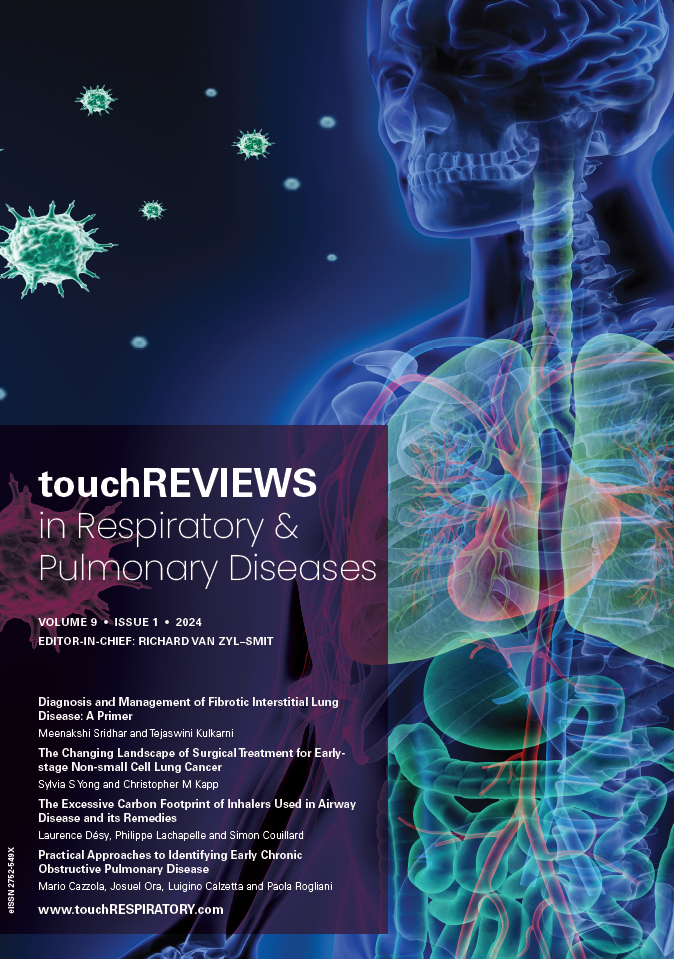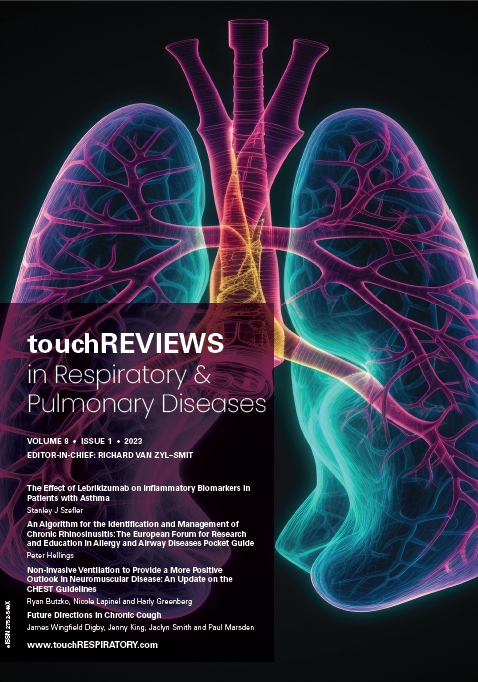US RESPIRATORY & PULMONARY DISEASES—VOLUME 5 ISSUE 1—WINTER 2020
Welcome to the Winter 2020 edition of US Respiratory & Pulmonary Diseases. Editorial Board member Anoop M Nambiar introduces the issue, which features reviews across a wide range of clinically relevant topics relating to interstitial lung disease, allergy, COVID-19, respiratory tract disorders, sleep related breathing disorders, and COPD and asthma. This edition also features a COVID-19 related editorial and expert interview, and a case report around respiratory intensive care. We trust you’ll find something that is of interest with respect to your own daily clinical practice.
As always, we thank all authors who contributed expertise to this exciting edition, and the Editorial Board for their continued support and guidance. If you are interested in submitting an article for the 2021 edition, you can do so here.
Foreword
Welcome to the latest edition of US Respiratory & Pulmonary Diseases, which aims to provide insightful and topical articles relevant to the everyday practice of busy physicians. COVID-19 continues to dominate headlines worldwide and is the focus of several of our articles. We begin with an expert interview in which Giorgio Canonica discusses the differences […]
Expert Interview
Globally, the coronavirus disease 2019 (COVID-19) pandemic, caused by severe acute respiratory syndrome coronavirus 2 (SARS-CoV-2), has infected in excess of 55 million people and is associated with over 1.3 million deaths to date (European Centre for Disease Prevention and Control data).1 COVID-19 is placing significant strain on all aspects of routine healthcare and has raised […]
Editorial
Smoking is a significant risk factor for severe COVID-19. A substantial amount of evidence supports the fact that tobacco use and chronic obstructive pulmonary disease (COPD) are among the strongest risk factors that lead to severe disease and high mortality due to COVID-19 illness. In a recent publication, Zhao et al. carried out a meta-analysis […]
Reviews
Chronic rhinosinusitis (CRS) is a clinical syndrome defined by symptomatic inflammation of the paranasal sinuses and nasal cavity for at least 12 weeks in duration. Historically, CRS has been classified into 2 subgroups, CRS with nasal polyps (CRSwNP) and CRS without nasal polyps. Those with CRSwNP have a more significant burden of disease and poor […]
Strategy reports from both the Global Initiative for Chronic Obstructive Lung Disease (GOLD) 20201 and the Global Initiative for Asthma (GINA) 20192 highlight the importance of using the triple combination of inhaled corticosteroids (ICS), long-acting β2-agonists (LABAs), and long-acting muscarinic receptor antagonists (LAMAs) in the treatment of chronic obstructive pulmonary disease (COPD) and asthma, respectively. However, there is […]
The COVID-19 pandemic has infected more than 61 million people and led to more than 1 million deaths worldwide.1 The USA was one of the later countries to experience large scale community transmission; to date, there have been 13.2 million cases and approaching 300,000 deaths attributed to COVID-19.1 The USA has the highest overall deaths globally.1,2 The COVID-19 […]
Systemic sclerosis (SSc) is an autoimmune disorder characterized by inflammation and fibrosis of the skin and other organs. It has a range of clinical manifestations, and the typical internal organs involved include the lungs, kidneys, heart, and gastrointestinal tract. Though it is an uncommon condition, the mortality rate of this disease is higher than any […]
As our ability to treat and manage chronic medical conditions improves, we will see a greater number of our patients manifesting physiologic as well as pathologic changes associated with aging. The objective of this article is to provide a brief overview of physiologic changes seen in the respiratory system with aging, and to discuss commonly […]
Sleep disordered breathing in children comprises a spectrum of abnormal breathing patterns associated with increased airflow resistance and sleep disruption. Sleep disordered breathing is categorized by severity into primary snoring, upper airway resistance syndrome, and obstructive sleep apnea (OSA). Pediatric OSA has a prevalence of up to 5% in children.1 The most common cause of increased […]
Obesity hypoventilation syndrome (OHS) is defined as daytime hypercapnia (awake resting PaCO2 of ≥45 mmHg) in the setting of obesity (body mass index [BMI] ≥30 kg/m2). Most, if not all, patients have some sleep disordered breathing in the form of obstructive sleep apnea (OSA) or sleep-related hypoventilation. Alternative causes of hypoventilation, such as severe pulmonary disease, […]
Case Report
Subcutaneous emphysema (SE) is relatively common in the intensive care unit (ICU) and often a complication of positive pressure ventilation.1,2 While typically self-limiting and benign, life-threatening sequela can develop. Progressive accumulation of subcutaneous air can result in significant compressive forces leading to the development of a rare clinical entity known as massive subcutaneous emphysema (MSE). The […]

Trending Topic
Subcutaneous emphysema (SE) is relatively common in the intensive care unit (ICU) and often a complication of positive pressure ventilation.1,2 While typically self-limiting and benign, life-threatening sequela can develop. Progressive accumulation of subcutaneous air can result in significant compressive forces leading to the development of a rare clinical entity known as massive subcutaneous emphysema (MSE). The […]
Journal Archive
US Respiratory & Pulmonary Diseases is a peer-reviewed, free-to-access, annual journal comprising review articles, case reports, practice guides, theoretical discussions, and original research. It features balanced and comprehensive articles written by leading authorities, addressing the most important and salient developments in the field of respiratory.
Latest articles videos and clinical updates - straight to your inbox
Log into your Touch Account
Earn and track your CME credits on the go, save articles for later, and follow the latest congress coverage.
Register now for FREE Access
Register for free to hear about the latest expert-led education, peer-reviewed articles, conference highlights, and innovative CME activities.
Sign up with an Email
Or use a Social Account.
This Functionality is for
Members Only
Explore the latest in medical education and stay current in your field. Create a free account to track your learning.
















